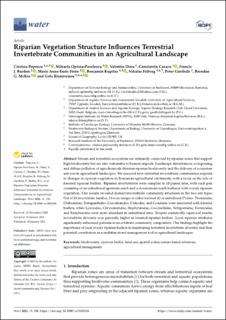Riparian Vegetation Structure Influences Terrestrial Invertebrate Communities in an Agricultural Landscape
| dc.contributor.author | Popescu, Cristina | |
| dc.contributor.author | Oprina-Pavelescu, Mihaela | |
| dc.contributor.author | Dinu, Valentin | |
| dc.contributor.author | Cazacu, Constantin | |
| dc.contributor.author | Burdon, Francis J. | |
| dc.contributor.author | Forio, Marie Anne Eurie | |
| dc.contributor.author | Kupilas, Benjamin | |
| dc.contributor.author | Friberg, Nikolai | |
| dc.contributor.author | Goethals, Peter | |
| dc.contributor.author | McKie, Brendan G. | |
| dc.contributor.author | Rîșnoveanu, Geta | |
| dc.date.accessioned | 2021-07-15T14:46:18Z | |
| dc.date.available | 2021-07-15T14:46:18Z | |
| dc.date.created | 2021-04-09T11:39:37Z | |
| dc.date.issued | 2021 | |
| dc.identifier.citation | Water. 2021, 13 (2). | en_US |
| dc.identifier.issn | 2073-4441 | |
| dc.identifier.uri | https://hdl.handle.net/11250/2764578 | |
| dc.description.abstract | Stream and terrestrial ecosystems are intimately connected by riparian zones that support high biodiversity but are also vulnerable to human impacts. Landscape disturbances, overgrazing, and diffuse pollution of agrochemicals threaten riparian biodiversity and the delivery of ecosystem services in agricultural landscapes. We assessed how terrestrial invertebrate communities respond to changes in riparian vegetation in Romanian agricultural catchments, with a focus on the role of forested riparian buffers. Riparian invertebrates were sampled in 10 paired sites, with each pair consisting of an unbuffered upstream reach and a downstream reach buffered with woody riparian vegetation. Our results revealed distinct invertebrate community structures in the two site types. Out of 33 invertebrate families, 13 were unique to either forested (6) or unbuffered (7) sites. Thomisidae, Clubionidae, Tetragnathidae, Curculionidae, Culicidae, and Cicadidae were associated with forested buffers, while Lycosidae, Chrysomelidae, Staphylinidae, Coccinellidae, Tettigoniidae, Formicidae, and Eutichuridae were more abundant in unbuffered sites. Despite statistically equivocal results, invertebrate diversity was generally higher in forested riparian buffers. Local riparian attributes significantly influenced patterns in invertebrate community composition. Our findings highlight the importance of local woody riparian buffers in maintaining terrestrial invertebrate diversity and their potential contribution as a multifunctional management tool in agricultural landscapes. | en_US |
| dc.language.iso | eng | en_US |
| dc.publisher | MDPI | en_US |
| dc.rights | Navngivelse 4.0 Internasjonal | * |
| dc.rights.uri | http://creativecommons.org/licenses/by/4.0/deed.no | * |
| dc.title | Riparian Vegetation Structure Influences Terrestrial Invertebrate Communities in an Agricultural Landscape | en_US |
| dc.type | Peer reviewed | en_US |
| dc.type | Journal article | en_US |
| dc.description.version | publishedVersion | en_US |
| dc.rights.holder | © 2021 by the authors. | en_US |
| dc.source.pagenumber | 20 | en_US |
| dc.source.volume | 13 | en_US |
| dc.source.journal | Water | en_US |
| dc.source.issue | 2 | en_US |
| dc.identifier.doi | 10.3390/w13020188 | |
| dc.identifier.cristin | 1903173 | |
| dc.relation.project | Norges forskningsråd: 264499 | en_US |
| cristin.ispublished | true | |
| cristin.fulltext | original | |
| cristin.qualitycode | 1 |
Files in this item
This item appears in the following Collection(s)
-
Publikasjoner fra Cristin - NIVA [2149]
-
Scientific publications [1172]

